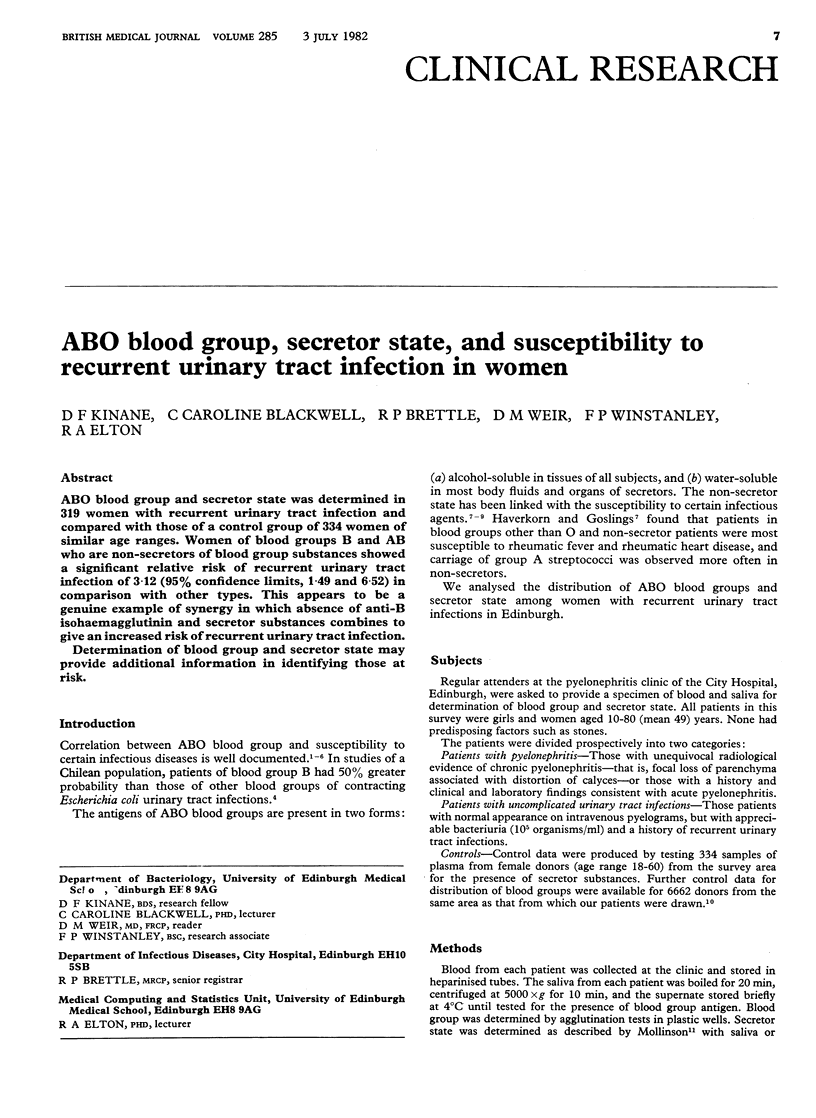Abstract
ABO blood group and secretor state was determined in 319 women with recurrent urinary tract infection and compared with those of a control group of 334 women of similar age ranges. Women of blood groups B and AB who are non-secretors of blood group substances showed a significant relative risk of recurrent urinary tract infection of 3.12 (95% confidence limits, 1.49 and 6.52) in comparison with other types. This appears to be a genuine example of synergy in which absence of anti-B isohaemagglutinin and secretor substances combines to give an increased risk of recurrent urinary tract infection. Determination of blood group and secretor state may provide additional information in identifying those at risk.
Full text
PDF


Selected References
These references are in PubMed. This may not be the complete list of references from this article.
- Barua D., Paguio A. S. ABO blood groups and cholera. Ann Hum Biol. 1977 Sep;4(5):489–492. doi: 10.1080/03014467700002481. [DOI] [PubMed] [Google Scholar]
- Boat T. F., Davis J., Stern R. C., Cheng P. W. Effect of blood group determinants on binding of human salivary mucous glycoproteins to influenza virus. Biochim Biophys Acta. 1978 Apr 19;540(1):127–133. doi: 10.1016/0304-4165(78)90441-5. [DOI] [PubMed] [Google Scholar]
- Chaudhuri A., DasAdhikary C. R. Possible role of blood-group secretory substances in the aetiology of cholera. Trans R Soc Trop Med Hyg. 1978;72(6):664–665. doi: 10.1016/0035-9203(78)90031-7. [DOI] [PubMed] [Google Scholar]
- Check J. H., O'Neill E. A., O'Neill K. E., Fuscaldo K. E. Effect of anti-B antiserum on the phagocytosis of Escherichia coli. Infect Immun. 1972 Jul;6(1):95–96. doi: 10.1128/iai.6.1.95-96.1972. [DOI] [PMC free article] [PubMed] [Google Scholar]
- Drach G. W. Antigens common to human and bacterial cells: tolerance or resistance to urinary and surgical infections. Surg Forum. 1971;22:67–68. [PubMed] [Google Scholar]
- Drach G. W., Reed W. P., Williams R. C., Jr Antigens common to human and bacterial cells: urinary tract pathogens. J Lab Clin Med. 1971 Nov;78(5):725–735. [PubMed] [Google Scholar]
- Foster M. T., Jr, Labrum A. H. Relation of infection with Neisseria gonorrhoeae to ABO blood groups. J Infect Dis. 1976 Mar;133(3):329–330. doi: 10.1093/infdis/133.3.329. [DOI] [PubMed] [Google Scholar]
- Grundbacher F. J. Immunoglobulins, secretor status, and the incidence of rheumatic fever and rheumatic heart disease. Hum Hered. 1972;22(4):399–404. doi: 10.1159/000152516. [DOI] [PubMed] [Google Scholar]
- Grundbacher F. J., Shreffler D. C. Effects of secretor, blood, and serum groups on isoantibody and immunoglobulin levels. Am J Hum Genet. 1970 Mar;22(2):194–202. [PMC free article] [PubMed] [Google Scholar]
- Haverkorn M. J., Goslings W. R. Streptococci, ABO blood groups, and secretor status. Am J Hum Genet. 1969 Jul;21(4):360–375. [PMC free article] [PubMed] [Google Scholar]
- Lincoln P. J., Dodd B. E. Variation in secretor and Lewis type frequencies within the British Isles. J Med Genet. 1972 Mar;9(1):43–45. doi: 10.1136/jmg.9.1.43. [DOI] [PMC free article] [PubMed] [Google Scholar]
- MUSCHEL L. H., OSAWA E. Human blood group substance B and Escherichia coli 086. Proc Soc Exp Biol Med. 1959 Aug-Sep;101:614–617. doi: 10.3181/00379727-101-25036. [DOI] [PubMed] [Google Scholar]
- Miler J. J., Novotny P., Walker P. D., Harris J. R., MacLennan I. P. Neisseria gonorrhoeae and ABO isohemagglutinins. Infect Immun. 1977 Mar;15(3):713–719. doi: 10.1128/iai.15.3.713-719.1977. [DOI] [PMC free article] [PubMed] [Google Scholar]
- Pradhan A. C., Chawla T. N., Samuel K. C., Pradhan S. The relationship between periodontal disease and blood groups and secretor status. J Periodontal Res. 1971;6(4):294–300. doi: 10.1111/j.1600-0765.1971.tb00620.x. [DOI] [PubMed] [Google Scholar]
- Robinson M. G., Tolchin D., Halpern C. Enteric bacterial agents and the ABO blood groups. Am J Hum Genet. 1971 Mar;23(2):135–145. [PMC free article] [PubMed] [Google Scholar]
- Rolleston G. L., Shannon F. T., Utley W. L. Relationship of infantile vesicoureteric reflux to renal damage. Br Med J. 1970 Feb 21;1(5694):460–463. doi: 10.1136/bmj.1.5694.460. [DOI] [PMC free article] [PubMed] [Google Scholar]
- Socha W., Bilińska M., Kaczera Z., Pajdak E., Stankiewicz D. Escherichia coli and ABO blood groups. Folia Biol (Krakow) 1969;17(4):259–269. [PubMed] [Google Scholar]
- Springer G. F. Blood-group and Forssman antigenic determinants shared between microbes and mammalian cells. Prog Allergy. 1971;15:9–77. [PubMed] [Google Scholar]
- Springer G. F. Importance of blood-group substances in interactions between man and microbes. Ann N Y Acad Sci. 1970 Feb 13;169(1):134–152. doi: 10.1111/j.1749-6632.1970.tb55979.x. [DOI] [PubMed] [Google Scholar]
- Weir D. M., Blackwell C. C., McLean C. A. Impaired bacterial binding to peritoneal exudate cells from mice with alloxan induced diabetes. J Clin Lab Immunol. 1981 Jan;5(1):37–40. [PubMed] [Google Scholar]


